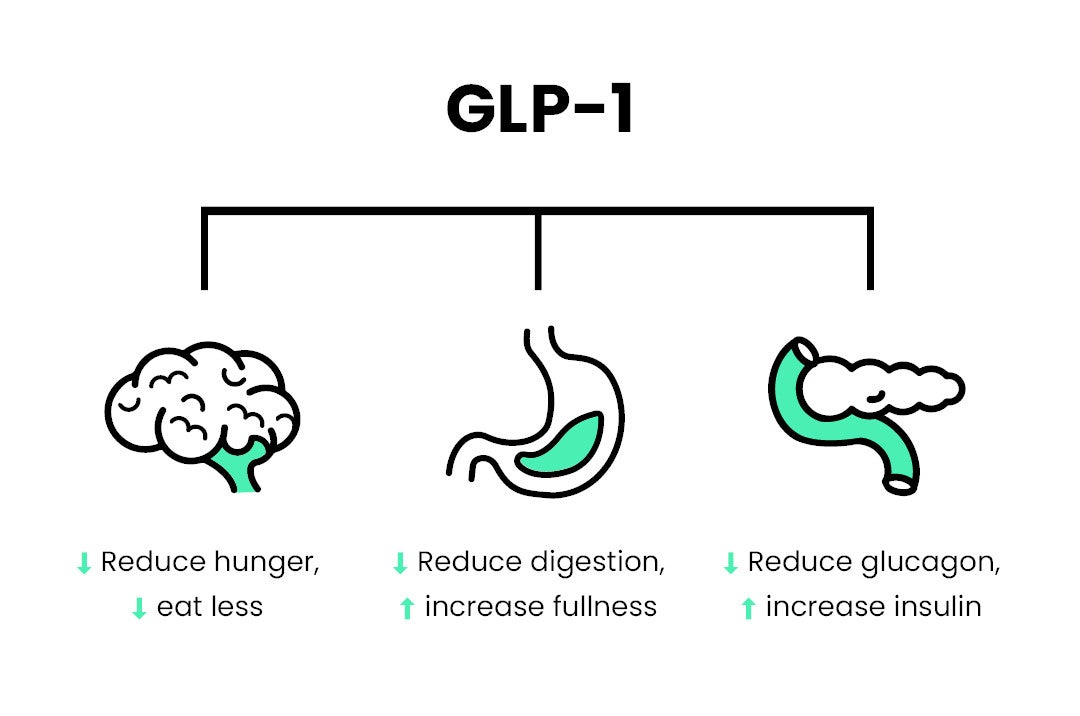Can GLP-1 Provide the Answer to Weight Loss?
Have you ever heard of GLP-1? Don’t worry if you haven’t, that’s why we’re here to help. Glucagon-like peptide 1, a.k.a GLP-1, is a hormone which is produced by your gut that helps control your appetite. Think of it as your "fullness hormone." It does this by talking to your brain, stomach, liver, and pancreas1.
When your GLP-1 levels are low, it can mess up your appetite control. You might end up overeating and, in some cases, even become obese2. But before we dive into how it works, let's first learn how your body makes GLP-1.
When you eat, your body makes GLP-1. It is mostly secreted from special cells called L cells in your small intestine, but a bit also comes from your pancreas and brain1. Once your body makes GLP-1, it travels through your bloodstream to talk to your brain, stomach, liver, and pancreas, telling them it's time to feel full.
GLP-1 & The Brain
The hypothalamus is the appetite controller in your brain. It keeps things in balance, making sure you eat the right amount and have enough energy. When GLP-1 is produced from your small intestine, it talks to the hypothalamus via the vagus nerve, which is the messenger between your gut and your brain (aka the gut-brain axis)3. When GLP-1 binds to receptors on the vagus nerve, it tells your brain to eat less. It can also stop the vagus nerve from sending hungry signals to your brain. So, it's like a double-action "fullness" signal to keep your appetite in check4.
GLP-1 & The Stomach
Your stomach is a key player in the activity of GLP-1 and appetite. When GLP-1 is sent out from your small intestine, it connects with receptors on your stomach lining5. This connection makes your stomach slow down the process of moving food along your gut. So, muscle waves that help digest your food, known as peristalsis, get less active. This means your stomach stays full for a longer time, sending signals to your brain that you're satisfied6. As a result, you feel less hungry, eat less, and it can help with losing weight.
GLP-1, The Liver & The Pancreas
Your liver handles sugar in your blood. When you're low on nutrients, it releases sugar. But when you've got too much sugar in your bloodstream, it stores that extra sugar as fat. That's where GLP-1 comes into play.
GLP-1 does two things. It helps your body release insulin, which helps your body to break down sugar for your body to use. Insulin is made by cells in your pancreas called Beta cells, sending signals to your brain to eat less and helps your body use up sugar, so it doesn't turn into fat as easily. It also tells your body to slow down on making a hormone called glucagon, which usually tells your liver to make more glucose (aka sugar)7. We want to keep glucagon low to stop your body from turning that extra glucose into fat cells, which can lead to weight gain.

GLP-1 & Obesity
There is some evidence that people dealing with obesity mayproduce less GLP-1. As a result, they can feel hungrier, eat bigger meals, and snack more, which can lead to gaining weight8. For people who struggle to naturally make enough GLP-1, there's good news: GLP-1 medications like Semaglutide can help with weight loss. These medications contain special proteins that act like GLP-1 and carry out all the functions we have discussed above such as slowing down how fast food leaves your stomach, leaving you feeling fuller for longer. This means you can be content with smaller portions and, in turn, lose weight4.
In a nutshell, taking GLP-1 medications can help you feel more satisfied and less hungry. This means you'll think about food less, be happy with smaller meals, and have the confidence and support to succeed in your weight loss journey.
Visit eMed’s Weight Management Programme to learn more about how you can access GLP-1 medications to begin your weight loss journey and sign up today!
References:
- L van Bloemendaal et al., 2014, Effects of glucagon-like peptide 1 on appetite and body weight: focus on the CNS, Journal of Endocrinology, 221 (1)
- T Tachibana, 2021, Glucagon-like peptide-1, Handbook of Hormones (Second Edition), Volume 1, pages 239-241
- L Baggio and D Drucker, 2014, Glucagon-like peptide-1 receptors in the brain: controlling food intake and body weight. Journal of Clinical Investigation, 124(10) pages 4223-6.
- J Wang JY et al., 2023, GLP-1 receptor agonists for the treatment of obesity: Role as a promising approach. Frontiers in Endocrinol (Lausanne), 14.
- E Broide E et al., 2013, GLP-1 receptor is expressed in human stomach mucosa: analysis of its cellular association and distribution within gastric glands. Journal of Histochemistry and Cytochemistry, 61(9), pages 649-58.
- P. Janssen et al., 2011, Review article: the role of gastric motility in the control of food intake, Alimentary Pharmacology and Therapeutics, 33, pages 880–894.
- I Rex et al., 2019, Glucagon Physiology, Endotext [Internet], Available from: https://www.ncbi.nlm.nih.gov/books/NBK279127/
- J Yu and M-S Kim, 2012, Molecular Mechanisms of Appetite Regulation, Diabetes and Metabolism Journal, 36(6), pages 391-398



